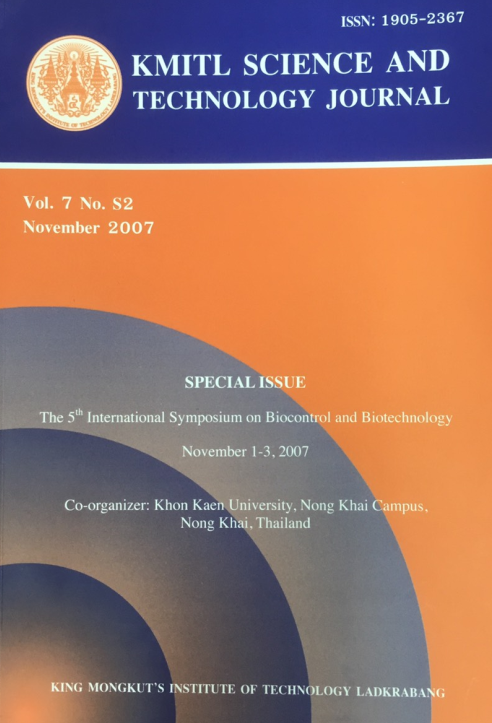STUDY OF PROTEASE ENZYME AND AMINO ACID CONTENTS IN SOY SAUCE PRODUCTION FROM PEAGION PEA AND SOY BEAN
Main Article Content
Abstract
Soy sauce is one of the flavoring agent product which was produced by the fermentation process of Aspergillus oryzae with a combination of soy bean, wheat flour and salt. The aim of this work is to analyse the amino acid contents in soy sauce produced from the mixture of peagion pea and soy bean compared with the original production process. In this study the protease enzyme was also monitored to evaluate the fermentation process. The soy sauces were prepared from 6 formulas by varying the ratios between peagion pea and soy bean : 100 : 0 (F1) , 80 : 20 (F2), 60 : 40 (F3), 40 : 60 (F4) , 20 : 80 (F5) and 0 : 100 (F6) (control). After the koji process, those koji molds were fermented with saline 20 % (w/v) for 90 days. The protease enzyme was analysed between the fermentation process at 0, 10, 30, 60 and 90 days by spectrometry. The amino acid contents were analysed by high performance liquid chromatography. The result showed that F5 moromi gave the highest content of glutamic acid and the content decreased as the ratio of soy bean decreased. The protease content in all formulas also increased as fermentation time increased. The peagion pea which was cultivated for animal food could be used as the replacement of soy bean to produce the value added product like soy sauce.
Keywords: soy sauce, soy bean, peagion pea, koji, Aspergillus oryzae, protease, amino acid
Corresponding author: E-mail: pornpi@swu.ac.th
Article Details
Copyright Transfer Statement
The copyright of this article is transferred to Current Applied Science and Technology journal with effect if and when the article is accepted for publication. The copyright transfer covers the exclusive right to reproduce and distribute the article, including reprints, translations, photographic reproductions, electronic form (offline, online) or any other reproductions of similar nature.
The author warrants that this contribution is original and that he/she has full power to make this grant. The author signs for and accepts responsibility for releasing this material on behalf of any and all co-authors.
Here is the link for download: Copyright transfer form.pdf
References
[2] Bovornsombat, S. 1981 Feasibility Study on Soy Sauce Production by Using Winged Bean Seeds. MSc Thesis, Kasetsart University. Bangkok.
[3] Soriano, M.R., Gonzalez, O. and Avelino, E. 1967 Studies on the Preparation of Soy Sauce from Coconut Paring Meal, Philippines Journal of Science, 96, 129-137.
[4] Crisistimi, L., Corpuz, C. and Cells, F.F. 1974 A Comparative Study on the Utilization of Mecan Pea for Soy Sauce Preparation.
[5] Nakadai, T. and Nasuno. 1977 The Action of Acid Proteinase from Aspergillus oryzae on Soybean Protein, Agric.Biol.Chem, 41, 409-410.
[6] Hesseltine, C.W. and Shibasaki, K. 1961 Miso III Pure Cuture Fermentation with Saccharomyces rouxii. Northen Regional Research Laboratory, Peoria, Illinois.
[7] Miller, G.L. 1959 Use of Dinitrosalicylic Acid Reagent for Determination of Reducing Sugar, Anal. Chem., 31, 426-429.
[8] Singh, H. and Jambunathan, R. 1991 A Survey of the Methods of Milling and Consumer Acceptable of Pigeon Peas in India. International Workshop on Pigeon Peas, Volume 2. India.
[9] Yong, F.M. and Wood, B.J.B. 1977 Microbial Succession in Experimental Soy Sauce Koji, J. Food Technol., 12, 163-157.
[10] Bhumiratana, A., Flegel, T. W., Glinsukon, T and Somporan, W. 1980 Isolation and Analysis of Molds from Soy Sauce koji in T


